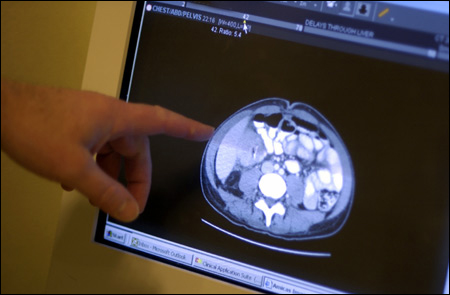‘Anatomy of a stem cell’
HARVARD STEM CELL INSTITUTE

Stem cell videos:
- Dr. Melton researches stem cells
- Dr. Scadden prescribes stem cell therapy
- HSCI hopes to accelerate research
- Dr. Scadden on embryonic stem cells
[default format for video is RealPlayer. For videos in Quicktime format, visit http://www.harvard.edu/multimedia/]
– More stories about stem cells
– Harvard Alumni Association videoconference on stem cells, “Unlocking the promise of stem cells”
– Harvard Stem Cell Institute hosts inaugural symposia (press release 4/23/04)
Stem cells are the fundamental source of all the body’s tissues, the template from which bodily cells are derived. As cells die off or are damaged, the hundreds of thousands of stem cells in the human body give rise – constantly – to new tissue. Injuries as simple as the scalding of the mouth with a hot beverage and as grave as the compromising of the immune system during chemotherapy require the activity of stem cells to repair cellular damage.
While all stem cells share certain unique attributes – the ability to self-renew and the ability to differentiate into various other types of cells – they are often divided into two primary types, embryonic and adult stem cells. Scientists are most interested in embryonic stem cells because these cells are capable of generating all the tissues in the body; they are unlimited in their potential. Embryonic stem cells are normally found in embryos at the blastocyst stage of development, a period just days after conception when the embryo is a hollow ball of no more than a few hundred cells that have not yet begun to differentiate into specific organs.
As human development proceeds both in the womb and after birth, the body’s stem cells become increasingly specialized. These more restricted cells are known as adult stem cells, and they give rise only to limited types of tissue. For instance, blood stem cells create red and white blood cells, among others, while neuronal stem cells give rise to cells of the brain and nervous system. Adult stem cells capable of forming new tissue have now been identified for most organs, although notably, not for the pancreas.
Adult stem cells are already used widely as a complement to chemotherapy: Oncologists inject stem cells into the bloodstream, and the cells migrate to areas of the body where they are needed to regenerate the immune system. The success of this model hints at tremendous opportunities for stem cells to be used to rebuild other tissues.
Researchers would like to use stem cells much more aggressively, harnessing their therapeutic power to generate virtually all types of damaged tissue. In addition to coaxing transplanted stem cells to replace bodily cells that have been harmed, scientists would also like to be able to enhance the ability of existing stem cells within the body to initiate repair.
To be maximally useful, stem cell science requires using a process in which the nucleus of an egg, which contains its genetic material, is removed and replaced by the genetic material from an adult cell. This egg, with its new nucleus, then grows into a cluster of cells from which investigators can derive stem cells matching the genetic identity of the patient who donated the implanted cells, and which are therefore unlikely to be rejected by the patient’s immune system. This technique, called somatic cell nuclear transfer, or therapeutic cloning, is distinct from the reproductive cloning used to create animals that are genetically identical to the parent.




